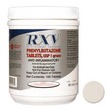Pronunciation
fen-ill-BYOO-tuh-zone - Pronunciation guide
Brand Names
- ButaJect
- ButaPaste
- ButaTabs E
- Bute
- Equi-Phar Phenylbutazone Injection 20%
- Phenylbutazone Powder
- Pributazone Boluses
Description
 Phenylbutazone is a nonsteroidal anti-inflammatory drug (NSAID) frequently prescribed for lameness, musculosketetal pain, muscle soreness, bone and joint problems, and laminitis.
Phenylbutazone is a nonsteroidal anti-inflammatory drug (NSAID) frequently prescribed for lameness, musculosketetal pain, muscle soreness, bone and joint problems, and laminitis.
As one of the most commonly prescribed medications for many musculoskeletel problems, it is often less expensive than other NSAIDs and is well tolerated by most horses. Although it does not speed healing or cure the underlying problem, phenylbutazone, which is quickly absorbed into the blood stream, produces pain relief and fever reduction quickly, thereby making the horse more comfortable.
Usage
Phenylbutazone is prescribed for lameness, musculoskeletal pain from soft tissue injury, muscle soreness, bone and joint problems, and laminitis. Some of phenylbutazone's actions may be dose dependent and it should be used under the guidance of appropriate veterinary evaluation and therapy so as not to mask the severity of the problem.
Dosage and Administration
 Phenylbutazone Phenylbutazone |
||||
|---|---|---|---|---|
| Method | Dosage (click row for calculator) |
Concentration | Period | Duration |
| Oral | 1-2 mg/lb | 1000 mg/tablet | Once or twice daily | NA |
| Intravenous injection1 | 1-2 mg/lb | 200 mg/ml | Once or twice daily | NA |
Notes:
|
||||
Side Effects
The most common side effect is ulceration of the mouth and gastrointestinal tract. Less common side effects include kidney damage, bleeding disorders, and protein loss.
Precautions
When used at the appropriate dose and according to directions, phenylbutazone is usually a safe and effective drug. Close monitoring and additional care should be taken when it is administered to foals, ponies, older horses, debilitated or dehydrated horses, horses with kidney or liver disease or GI problems, or horses that are pregnant or lactating.
Injection site reactions can occur, and the manufacturer's directions for proper injection should be followed carefully.
Phenylbutazone is FDA approved for use with horses and is a prescription drug. U. S. federal law restricts this drug to use by or on the lawful written or oral order of a licensed veterinarian.
Phenylbutazone is a regulated or prohibited substance in most sanctioned competitions. In each case, the proper regulatory group should be consulted.
Interactions
Phenylbutazone should not be combined with other anti-inflammatory drugs that tend to cause GI ulcers, such as corticosteroids and other NSAIDs.
Avoid using phenylbutazone with anticoagulant drugs, particularly coumarin derivatives, such as warfarin.
Overdose
Overdoses of phenylbutazone can cause GI ulcers, protein loss, kidney and liver damage, and death. Early signs of toxicity include loss of appetite, ulcers in the mouth, and depression.
Images
 Phenylbutazone Tablets
Phenylbutazone Tablets
 Superiorbute Phenylbutazone Powder
Superiorbute Phenylbutazone Powder
Literature
